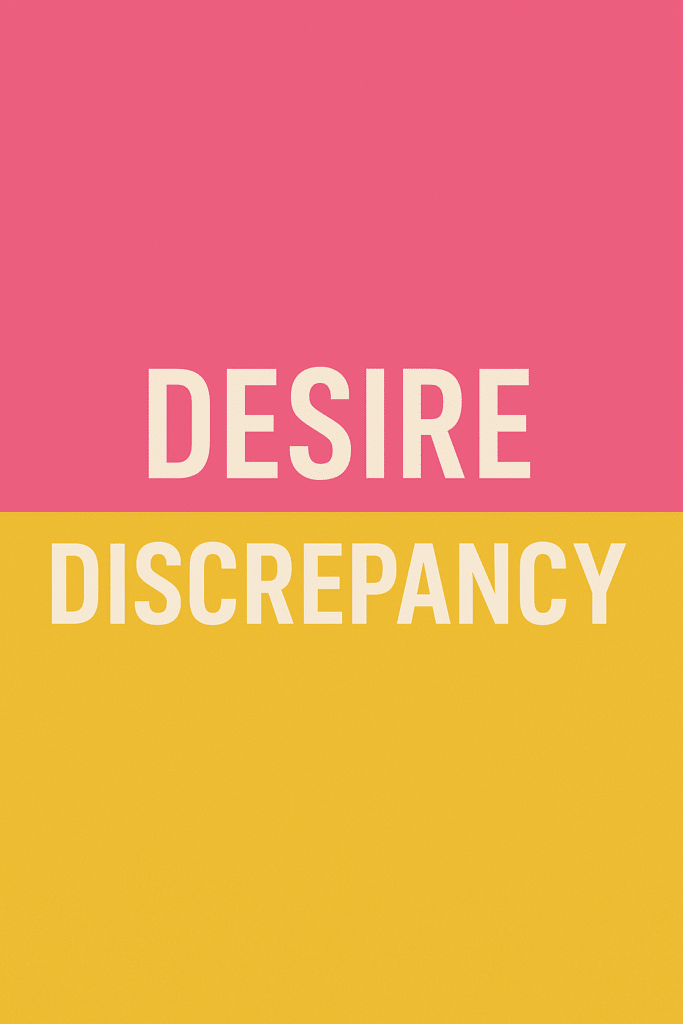 Understanding Desire Discrepancy
Understanding Desire Discrepancy
The media often portrays sexual desire as constant—either you have it, or you don’t. We see couples in movies and TV shows filled with passion, then riding off into the sunset, with little insight into how their desire evolves over time. But in reality, libido is fluid and influenced by various factors.
Desire discrepancy occurs when partners have different levels of sexual desire. This mismatch may exist from the beginning of a relationship or emerge over time. It can be temporary, triggered by external factors, or a more persistent issue. However, it’s essential to understand that desire differences are normal. Most couples will experience them at some point, and they are not necessarily a sign of incompatibility or failure.
The Science Behind Desire Discrepancy
Libido is shaped by biological, psychological, and social factors. Some key influences include:
- Biological: Age, hormonal changes, medications, chronic pain, and overall health.
- Psychological: Stress, anxiety, depression, and mental health conditions.
- Social: Religious upbringing, cultural messaging, parenthood, and past experiences with shame or guilt.
Additionally, there are different types of sexual desire. In Come As You Are, Dr. Emily Nagoski explains the difference between spontaneous and responsive desire:
- Spontaneous desire: Feeling desire first, then experiencing arousal and engaging in sexual activity.
- Responsive desire: Experiencing arousal or engaging in sexual behavior before feeling desire.
Many people assume desire should always be spontaneous, but responsive desire is just as valid and often more common, particularly in women. Recognizing these differences can help individuals better understand their libido and reconnect with their partners.
Debunking Common Myths About Desire Discrepancy
Myth #1: One Partner is “Broken” or Not Attracted Enough to the Other
Lower desire does not mean someone is broken. Libido fluctuates, and a decrease in sexual interest doesn’t necessarily mean a loss of attraction. Many external factors can influence sex drive, and assuming otherwise can create unnecessary stress.
Myth #2: A Higher Sex Drive Means Someone is More Loving or Passionate
Libido isn’t a measure of love or passion. A person with a naturally higher sex drive isn’t inherently more affectionate than someone with lower desire. Sexual frequency and emotional connection are not the same thing.
Myth #3: Desire Should Always Be Spontaneous, Like in Movies
Spontaneous desire is great, but relying on it alone can set unrealistic expectations. Responsive desire—where intimacy and arousal come before the feeling of desire—is just as valid and often more sustainable in long-term relationships.
For even more sex myths debunked read this: 5 Sex Myths Ruining Your Intimacy and How to Overcome Them
The Emotional and Relational Impact of Mismatched Desire
Misinformation about libido can cause individuals to panic when their desire shifts. This can lead to:
- Frustration, insecurity, or resentment.
- Avoidance of intimacy due to fear of rejection.
- Pressure to “fix” the issue without understanding its root cause.
- Miscommunication, making the problem worse.
When facing desire differences, it’s crucial to see it as a shared challenge rather than an individual failing. Both partners play an equally important role in navigating the issue, and it should never be framed as the “low-desire” partner’s problem to solve alone.
5 Communication Strategies for Couples
Effective communication is key to addressing desire discrepancy. Here are five strategies to help:
- Reflect together – Identify any recent changes in lifestyle, health, or relationship dynamics that could be affecting libido.
- Use “I statements” – Focus on sharing your own experiences rather than making accusations. (e.g., “I miss feeling close to you” instead of “You never want sex.”)
- Avoid blame – Explore the root causes with curiosity, not judgment.
- Create space for both perspectives – Recognize that both partners’ feelings are valid and deserve attention.
- Collaborate on solutions – Work together as a team to set expectations and create changes that feel good for both of you.
Compromising and Finding Creative Solutions
If you and your partner are struggling with mismatched libidos, consider:
- Expanding your definition of intimacy – Sexual connection isn’t just about intercourse. Explore other ways to be sensual and affectionate.
- Scheduling intimacy – While it may not sound sexy, planning intimacy can help people with responsive desire feel more engaged and present.
- Reducing stressors – Addressing outside stress (work, parenting, etc.) can remove barriers to sexual desire.
- Exploring eroticism together – Engage in open conversations about fantasies, desires, and turn-ons to reconnect in a new way.
The goal is to meet each other’s needs without pressure, guilt, or coercion. If you’re feeling stuck, seeking professional support can be incredibly beneficial.
When to Seek Professional Help
A trusted therapist—especially a sex therapist—can help couples navigate desire differences in a constructive way. You may want to seek support if:
- Deeper emotional issues, such as trauma, resentment, or attachment struggles, are at play.
- You need tools to mediate discussions about sex.
- You want to explore how your relationship and sexual self can evolve over time.
Rebuilding Connection
Desire discrepancy is common, normal, and something couples can navigate successfully. The key is to approach it with curiosity, communication, and collaboration rather than frustration or blame. Intimacy isn’t just about frequency—it’s about connection, pleasure, and feeling valued.
If you’re looking for support, our AASECT-certified sex therapists are here to help. We offer free 15-minute consultations—click here to schedule yours today!

